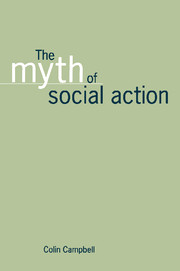Book contents
- Frontmatter
- Contents
- 1 Introduction
- 2 Action reported missing in action theory
- 3 Action and social action
- 4 Action versus social action
- 5 The rise of social situationalism
- 6 The argument by denial
- 7 Accounts and actions
- 8 The argument by exclusion
- 9 The argument through incorporation
- 10 The ‘learning everything from others’ thesis
- 11 The communicative act paradigm
- 12 The linguistic turn for the worse
- 13 The myth of social action
- 14 The obstacle which is social situationalism
- 15 Epilogue: bringing action back in
- Notes
- Bibliography
- Index
9 - The argument through incorporation
Published online by Cambridge University Press: 07 May 2010
- Frontmatter
- Contents
- 1 Introduction
- 2 Action reported missing in action theory
- 3 Action and social action
- 4 Action versus social action
- 5 The rise of social situationalism
- 6 The argument by denial
- 7 Accounts and actions
- 8 The argument by exclusion
- 9 The argument through incorporation
- 10 The ‘learning everything from others’ thesis
- 11 The communicative act paradigm
- 12 The linguistic turn for the worse
- 13 The myth of social action
- 14 The obstacle which is social situationalism
- 15 Epilogue: bringing action back in
- Notes
- Bibliography
- Index
Summary
The third and most common argument employed by situationalists to justify reducing the classical trichotomy to the modern dichotomy is the argument through incorporation and reverse dependency. The advocates of this argument resolve the problem of the relationship between action and social action by collapsing the two concepts into one: more specifically, by absorbing the first into the second. Something which is achieved by claiming that the critical defining feature of action, that is its ‘meaningfulness’, is necessarily a social quality. Consequently, it is claimed that there cannot be such a thing as ‘action’ which is not, in reality, ‘social action’ (or at the very least, dependent on it) and hence that the former term is redundant. In effect, therefore, this position involves denying the possibility of an interpretive action theory tradition, claiming that there can only be an interpretive social action theory tradition. As we have seen, this position rests on a critical syllogism concerning action, social action and meaning and especially upon its major premise, the assertion that all meaning is necessarily social. This empirical claim will thus be the focus of the following discussion. But first there are two general observations to be made about the logical status of the incorporationist justification for collapsing the classical trichotomy to the modern dichotomy.
- Type
- Chapter
- Information
- The Myth of Social Action , pp. 94 - 103Publisher: Cambridge University PressPrint publication year: 1996



